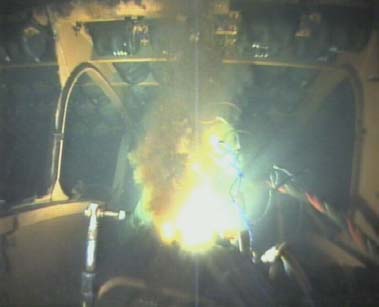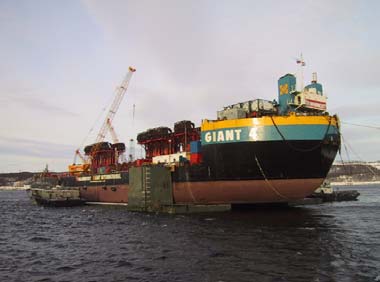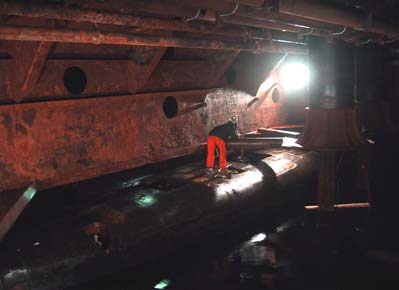conditions simulating the impulse and vibration environments. Particular regard was given to the vibration spectra that was to be generated by the M-S cutting technique deployed to sever the bow section, since there was a possibility that a sympathetic vibration could not only result in the release of the cap of the first starboard side missile silo which had been damaged during the original explosion, but it could also override one of the acceleration/deceleration sensitive latches of the weapon firing system.
ESTABLISHING THE POTENTIAL FAULT CONDITIONS DURING M-S OPERATIONS
Pressure Hull Lifting Sockets: Lifting of the
The potential fault scenarios primarily related to cutting through the submarine ship’s services occupying the cavity between the casing and pressure hull. Although engineering drawing details had been provided and location trials had been conducted on the sister boat

Difficulties for the saturation divers undertaking these tasks (surveying the locations and setting up the robotic, high pressure grit cutting equipment) included encountering pockets of explosive gases (three relatively small gas burns/explosions were experienced), and contamination by, particularly, hydraulic gels and asbestos products used in the acoustic tiling bonding system to the outer casing. Procedures had to be introduced for the divers to decontaminate themselves of oils and fibers before entering the saturation chambers on board the diving ship Mayo for shift breaks over each diver’s spell of two to four weeks under a full saturation environment.
Lift, Sea, State and Other Factors: Limits on sea state had to be imposed during the lift and transit phases of the recovery operation.
First, lifting operations could not proceed at sea state swell (peak to peak) heights greater than 2.5m because of the limit ram stroke of swell compensation system acting on the strand jacks — this system maintained a uniform cable tension during the lift. The entire 110m lift was scheduled for at a minimum period of 10 hours so a fair weather window of at least this was necessary to ensure safety throughout the lift. If weather conditions deteriorated during the lift then the lift would have to be abandoned and the
Second, during the transit phase when the
Other factors that had to be accounted for included excessive suction binding the
The local seabed at the
In reserve, if the stern lift failed to break suction, a line tethered to two tugs was to be passed under the stern of the
In the event, there was no suction, the first movement of the
BARGE AND DIVING SUPPORT VESSEL ACTIVITIES — RADIATION RISK
As well as the pre-prepared arrangements for response to a serious mishap to the

The NCG cooperated with the RF over analysis of a hypothetical radioactive release from the reactor compartment at the stage when the lifting
• expansion of the air/gas bubble drives a discharge of 150m3 of water from the reactor compartment via the 6mm diameter instrumentation hole (a known open route into the reactor compartment), taking 36 hours.
• the discharged water contains fission and activation products released from fuel corroded for 14 months by seawater, as determined by a representative test, amounting to some 3?1012 Bq (Becquerel). Allowing for dilution in the sea, the total effective dose to a barge crewmember would be less than 1 ?Sv (at less than 0.1 ?Sievert/hour). Further development of this model analysis concluded that:
• a larger leak path would not significantly affect the above conclusion.
• if the same amount of fission and activation products were not discharged by the bubble expansion, but remained at the top of the reactor compartment, the 2m of seawater that will fill the space between the pressure hull and the casing would reduce the dose rate to a barge crew member to a few ?Sv/hour.
To mitigate these risks and those from uncontrolled criticality, discharge of radioactivity or direct radiation resulting in unacceptable levels of exposure, emergency arrangements to protect personnel, including evacuation by the RF Northern Fleet vessels and aircraft, were agreed with the RF Northern Fleet. These actions, triggered by an emergency reference level (ERL) protocol, applied to all personnel present on board M-S vessels.

OVERVIEW

